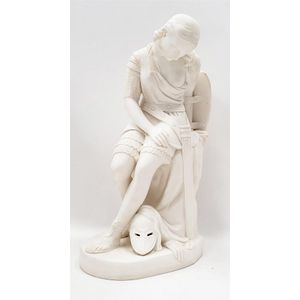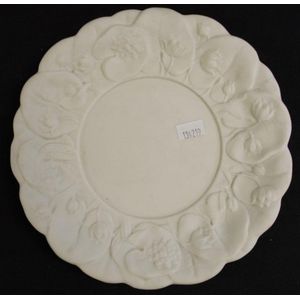
Rare Pair of Minton Parian Ware Busts of Royalty
A rare pair of Minton parian ware busts of William IV and Queen Adelaide, English circa 1835, 17 cm and 19 cm high, on glazed socle bases. Provenance: Havelock House Antiques, Goolwa, South Australia 1984

Minton Tinted Parian Figures: 'Psyche' and 'Pandora' (1873-1874)
A pair of Minton tinted parian figures, 'Psyche' and 'Pandora', dated 1873 and 1874, after Albert-Ernest Carrier-Belleuse, each modelled standing against a tree stump, half draped and holding their respective attributes, the skin and foliage in white,…

Minton Parian Ware Figure: Clorinda, Model by John Bell
A Minton parian ware figure, depicting Clorinda, after the model by John bell (1812-1895), 1848, with inscribed mark of John bell, February 1848 to reverse; pattern 203, the weary figure of Clorinda the pagan warrior in battle dress, her helmet and gloves…

Minton Parian Ware Figure: Solitude by J. Lawlor, 19th Century
A Minton parian ware figure, Solitude, by J. Lawlor, 19th century, modelled in the classical manner as a semi nude female in a seated position with a downcast head and a stork at her side, impressed Art Union of London, 1852 and J. Lawlor sculp to reverse…

"Canova" Parian Woman Figure, c.1880
Minton parian ware figure of a classical woman entitled 'Canova' c1880

Mintons Parian Blossom Plate, 20cm
Antique Mintons Parian plate embossed blossom decoration, diameter 20 cm

Victorian Minton Parian 'The Kiss' Open Salt Figure
Victorian Minton Parian group 'The Kiss' open salt figure of 'The Kiss' incorporating pair open salts, circa 1860, height 15 cm

Minton's Parian Ariadne & Panther Sculpture (1862) by Bell
Minton parian model of Ariadne and the panther England C1862 after sculpture by Johann Heinreich Von Dannecker attributed to John bell (toe missing)

Victorian Parian Gypsy Figure, Minton Attribution
Victorian Parian ware figure of a Gypsy carrying a basket, attributed to Minton, height 16 cm. Ex Alan Landis Antiques.

Minton Parian Figure of Clorinda, 1848
A Minton parian ware figure of 'Clorinda', after the model by John bell (1812-1895), 1848, with inscribed mark of John bell and date, February 1848; pattern 203, the weary figure of Clorinda the pagan warrior in battle dress, her helmet and gloves at her…

"Solitude" Parian Statue by J. Lawlor, 1852
A Minton parian ware statue of 'Solitude', 1852, by J. Lawlor for the Art Union of London, a contemplative semi-clad classical maiden seated upon a rock and flanked by a heron, incised title to the base, impressed marks of J. Lawlor and the Art Union of…

Naomi and Daughters-in-Law Parian Figurine
A Minton parian figural group, Naomi and her Daughters in Law, circa 1865, depicting the biblical characters of Naomi, Ruth and Oprah, titled to the front of the base, impressed Minton to base, along with a date mark, 33 cm high

John Bell's Lalage Parian Figure with Lizard & Bouquet
Minton parian ware 'Lalage' figure by John bell in a simple tunic of fine material, seated with her hands clasped over one knee & head gently tilted in a pensive gaze, crisply modelled bouquet is supported at her wrist & at her feet a lizard scampers over…

Minton Parian Figurine: Miranda by J. Bell
A Minton Parian figurine, 'Miranda', a young woman with flowing hair sits atop a rock with the waves lapping at her feet and a large shell to one side. Impressed marks to the base 'J. Bell & Miranda', with the Minton stamp underneath the base, hairline…
 Loading more...
Loading more...